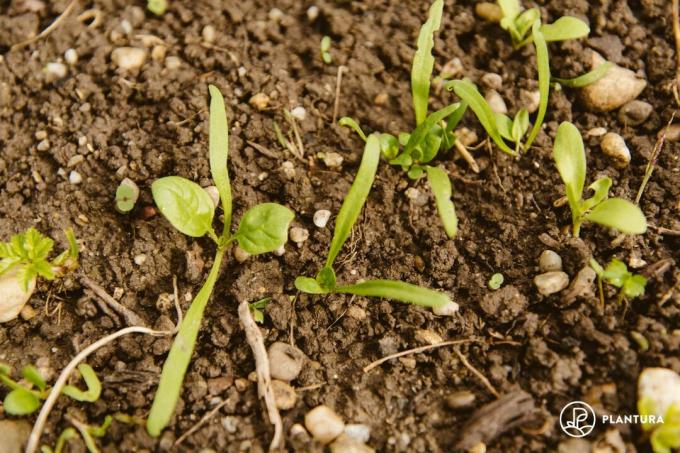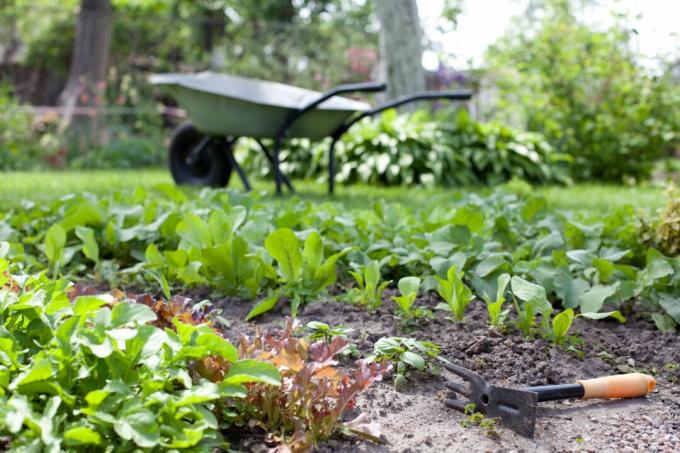Growing spinach is easy and promising even for beginners. We reveal what you should consider when growing spinach in terms of timing, location and procedure. We also give tips on care and overwintering.

Who fresh spinach (Spinacia oleracea) in your own garden is not only good for your health, but is also rewarded with good yields thanks to the easy-care cultivation. The annual leafy vegetable of the foxtail family (Amaranthaceae) is a typical no-till vegetable. In this article you will find out which varieties are available, how spinach is cultivated and how to care for it properly.
contents
-
Growing spinach: how to do it
- When is spinach grown?
- The ideal location for spinach
- How to grow spinach outdoors
- How to grow spinach in a pot
- care for spinach
- Overwinter spinach
- Diseases and Pests in Spinach
Growing spinach: how to do it
When is spinach best grown? Where is the ideal location for spinach? And what is the best way to go about sowing? We answer these questions in the following section.
When is spinach grown?
Spinach can be grown at different times of the year, spring and autumn are typical. In principle, however, year-round outdoor cultivation is also feasible if the spinach is cultivated in a sheltered location throughout the winter. Choosing the right variety is crucial to successful cultivation. Which variety is the right one depends on the climatic conditions of the respective season. For example, if you want to sow and harvest spinach in summer, you should use particularly bolt-resistant varieties. This means that these strains will not flower as quickly in the warm summer temperatures. However, they are more sensitive to cold.
More about the different spinach varieties find out here.
Tip: Originally, spinach had either male or female plants. However, thanks to new breeds, there are now spinach varieties that have both male and female flowers. This change can have a positive effect on successful pollination and variety stability.
If you would like to harvest your first spinach before the start of summer, sow it from the end of February until April. Since cold snaps in the garden are still common at this time, it is advisable to cover the young plants with fleece. Since spinach generally only tolerates light frosts, a protective layer of brushwood, fleece or even snow is also essential for winter spinach. The table below shows how far harvest follows sowing.
| sowing | harvest | |
|---|---|---|
| spring spinach | Late February - early April | May June |
| summer spinach | April - end of June | June August |
| autumn spinach | July September | September - December |
| winter spinach | Late September - early October | April |
Tip: Due to its deep roots, spinach is also perfect as a green manure for loosening the soil. During the winter he can thus already prepare the ground for the next planting season.
The ideal location for spinach
Spinach likes sunny to partially shaded locations. Depending on the variety, however, the ideal location for the leafy vegetables varies. For example, summer spinach should be in light shade, while winter spinach prefers a sunny location. Since spinach develops taproots up to 1.20 meters deep, loose soil is important. The substrate should also be rich in humus, well drained and have a pH of 6.5 to 7.5. You can achieve a humus-rich vegetable bed, for example, with a well thought-out humus economy and the regular use of mostly organic fertilizers. Our Plantura organic soil activator can be incorporated into the soil before sowing. It ensures more soil fertility and increases the humus content.

Where to grow spinach
- Sunny to semi-shady location
- Loose, well drained soil
- Humus and nutrient rich soil
- Ideal pH: 6.5 - 7.5
Tip: Good planting neighbors for spinach in one mixed culture are strawberries (Fragaria), radish (Raphanus sativus var. sativus), Kohlrabi (Brassica oleracea var. gongylodes), leek (Allium porrum) or tomatoes (Solanum lycopersicum). Spinach does not go well with Beetroot (Beta vulgaris subsp. vulgaris var. conditions).
How to grow spinach outdoors
Spinach is sown directly outdoors. There it is sown in rows, otherwise the spinach hardly has a chance against weeds. Important maintenance measures such as hoeing can also be carried out much more easily between the rows. Before you start sowing, loosen the soil a little and free it from weeds. In order to give the spinach the best conditions for growth, prepare the soil optimally. Spinach needs loose, well-drained soil with a good water supply. To achieve that, you can overheavy floors with our Plantura organic vegetable soil or lose sand. Too light, sandy soils are upgraded with Plantura organic vegetable soil. In order to provide the plant with enough nutrients right from the start, it is advisable to fertilize the soil before sowing. You work for this Plantura organic universal fertilizer with organic long-term effect or compost into the soil. If the soil is too acidic for growing spinach, the pH can be adjusted by liming or alternative fertilizers such as eggshells or wood ash can be adjusted.
The seed is then pressed 2 to 3 centimeters deep into the soil at a planting distance of 8 to 12 centimeters. The distance between the rows is 20 to 30 centimeters. Spinach germinates and grows at very low temperatures, but should be covered with fleece if there is a risk of frost. After sowing, pat down the soil and water carefully. After six to eight weeks, the spinach can finally be harvested.

Tip: If you want to continuously harvest fresh spinach in your garden, it pays to reseed the spinach at regular intervals.
Summary of growing spinach:
- Soil preparation: promote humic, loose soil, e.g. B. with soil activator
- Too heavy, loamy soils with Plantura organic tomato & vegetable soil or loosen sand
- Enrich soil with nutrients, for example 70 - 150 g/m² Plantura organic universal fertilizer or compost
- If necessary, increase the pH value by liming or a Fertilization with wood ash or eggshells
- Place seeds 2 – 3 cm deep
- Planting distance: 8 - 12 cm
- Row spacing: 20 – 30 cm
- Ideal germination temperature: 10 – 20 °C
- Cover with fleece if there is a risk of frost
- Harvest after 6-8 weeks
How to grow spinach in a pot
Even if you don't have a suitable bed area, you can grow spinach yourself, because the versatile leafy vegetable can grow in pots on the balcony or terrace even in the smallest of spaces. It should be noted that the vessel has a minimum depth of 30 to 40 centimeters so that the spinach can form its deep roots.
Tip: In order to be able to grow well in the pot, spinach needs a good, adapted substrate. Our plants Organic tomato & vegetable soil has everything your spinach needs to grow: it is permeable, ensures a good water supply and has the ideal pH value for spinach above 6.5.
care for spinach
Spinach is one of the moderately consuming plants. In order to cover the nutrient requirements of the plant, you should apply a predominantly organic fertilizer or your own compost. Our Plantura Organic universal fertilizer is ideal for this because it is completely animal-free and provides your plants with all the important nutrients throughout the gardening season. On the other hand, you should avoid excessive nitrogen fertilization due to the nitrate accumulation in the leaves.
Although spinach is a frugal plant, regular watering is necessary. The soil should be moist, but the plant does not tolerate waterlogging. It is best to water more often in small amounts. Regular raking and weed removal have also proven useful in cultivation, since the spinach cannot assert itself if excessive weed development occurs and its growth is thus inhibited.
Caring for spinach at a glance:
- Mainly organic fertilization with Plantura organic universal fertilizer or compost
- Water regularly
- Remove and rake weeds
Tip: If you're growing spinach in the summer, it's best to water early in the morning or late in the afternoon. In this way, the amount of evaporation is reduced and you save water.
Overwinter spinach
If you want to harvest spinach very early in the new year, you can sow the spinach in the previous year - in September to October. The plant then overwinters outdoors. The little plants survive the cold best when they have already developed two to four leaves. When there are frosts outside, it is important to cover the spinach. Kahlfrost means it freezes without an insulating layer of snow. This can quickly lead to cold damage, especially in young plants.

Diseases and Pests in Spinach
Spinach is quite easy to grow, but the downy mildew sometimes problems. In the meantime, however, there are enough new varieties that have good to very good resistance to the fungal disease. Regular ventilation should be ensured, especially when growing in a polytunnel. Outdoors, it is advisable to water the plants as close to the roots as possible so that downy mildew has less surface area to attack, because the fungus depends on leaf wetness. If the plants are already infected, unfortunately there is not much to save. Then it is advisable to chop off the culture and dispose of it in the residual waste. This drastic measure is appropriate because there is a risk that the fungus will survive in the compost and its spores will spread throughout the garden. Also from the cucumber (Cucumis sativus) well-known leaf spot disease occurs occasionally. Pests rarely visit the spinach Black bean aphid (Aphis fabae) can, however, cause problems for the spinach. On the other hand, in early summer, the plants can be covered with a net until harvest.
If the spinach has been properly grown, it will soon be time to harvest the leafy greens. All about the Harvesting, storing and using spinach you can read here.
